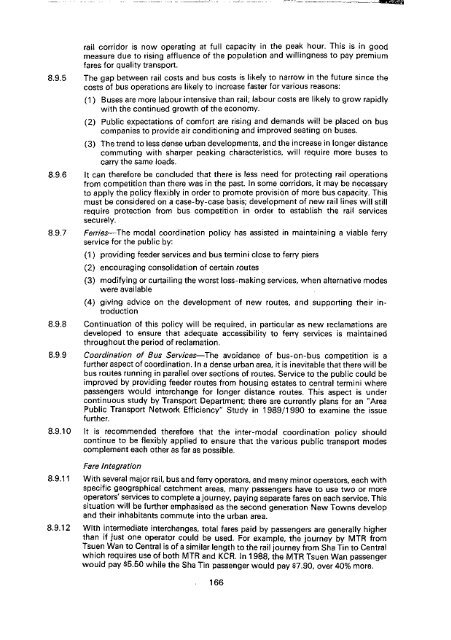Untitled - HKU Libraries - The University of Hong Kong
Untitled - HKU Libraries - The University of Hong Kong
Untitled - HKU Libraries - The University of Hong Kong
- No tags were found...
You also want an ePaper? Increase the reach of your titles
YUMPU automatically turns print PDFs into web optimized ePapers that Google loves.
ail corridor is now operating at full capacity in the peak hour, This is in goodmeasure due to rising affluence <strong>of</strong> the population and willingness to pay premiumfares for quality transport.8.9.5 <strong>The</strong> gap between rail costs and bus costs is likely to narrow in the future since thecosts <strong>of</strong> bus operations are likely to increase faster for various reasons:(1) Buses are more labour intensive than rail; labour costs are likely to grow rapidlywith the continued growth <strong>of</strong> the economy.(2) Public expectations <strong>of</strong> comfort are rising and demands will be placed on buscompanies to provide air conditioning and improved seating on buses.(3) <strong>The</strong> trend to less dense urban developments, and the increase in longer distancecommuting with sharper peaking characteristics, will require more buses tocarry the same loads.8.9.6 It can therefore be concluded that there is less need for protecting rail operationsfrom competition than there was in the past. In some corridors, it may be necessaryto apply the policy flexibly in order to promote provision <strong>of</strong> more bus capacity. Thismust be considered on a case-by-case basis; development <strong>of</strong> new rail lines will stillrequire protection from bus competition in order to establish the rail servicessecurely.8.9.7 Ferries—<strong>The</strong> modal coordination policy has assisted in maintaining a viable ferryservice for the public by:(1) providing feeder services and bus termini close to ferry piers(2) encouraging consolidation <strong>of</strong> certain routes(3) modifying or curtailing the worst loss-making services, when alternative modeswere available(4) giving advice on the development <strong>of</strong> new routes, and supporting their introduction8.9.8 Continuation <strong>of</strong> this policy will be required, in particular as new reclamations aredeveloped to ensure that adequate accessibility to ferry services is maintainedthroughout the period <strong>of</strong> reclamation.8.9.9 Coordination <strong>of</strong> Bus Services—<strong>The</strong> avoidance <strong>of</strong> bus-on-bus competition is afurther aspect <strong>of</strong> coordination. In a dense urban area, it is inevitable that there will bebus routes running in parallel over sections <strong>of</strong> routes. Service to the public could beimproved by providing feeder routes from housing estates to central termini wherepassengers would interchange for longer distance routes. This aspect is undercontinuous study by Transport Department; there are currently plans for an "AreaPublic Transport Network Efficiency" Study in 1989/1990 to examine the issuefurther.8.9.10 It is recommended therefore that the inter-modal coordination policy shouldcontinue to be flexibly applied to ensure that the various public transport modescomplement each other as far as possible.Fare Integration8.9.11 With several major rail, bus and ferry operators, and many minor operators, each withspecific geographical catchment areas, many passengers have to use two or moreoperators' services to complete a journey, paying separate fares on each service. Thissituation will be further emphasised as the second generation New Towns developand their inhabitants commute into the urban area.8.9.12 With intermediate interchanges, total fares paid by passengers are generally higherthan if just one operator could be used. For example, the journey by MTR fromTsuen Wan to Central is <strong>of</strong> a similar length to the rail journey from Sha Tin to Centralwhich requires use <strong>of</strong> both MTR and KCR. In 1988, the MTR Tsuen Wan passengerwould pay $5.50 while the Sha Tin passenger would pay $7.90, over 40% more.166
















